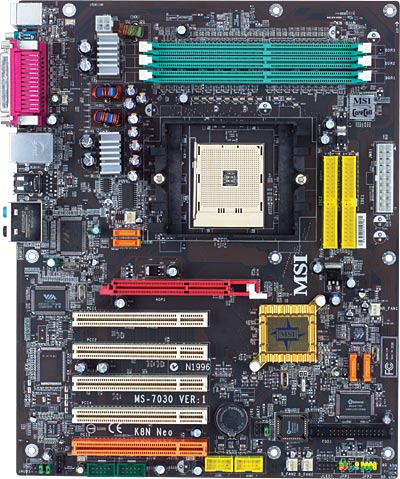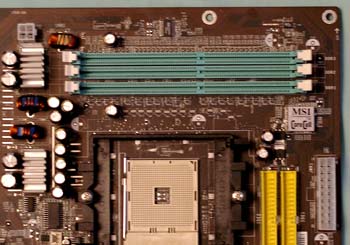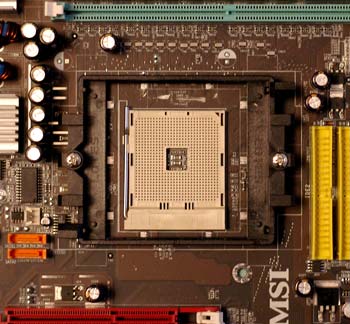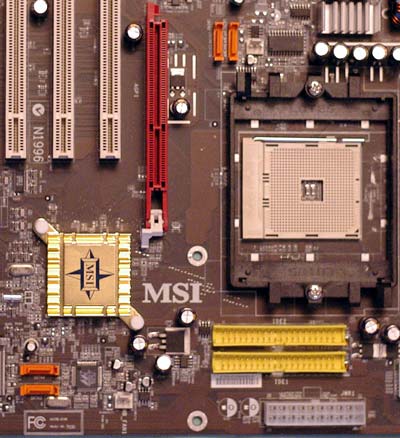MSI K8N Neo Platinum: First nForce3-250Gb
by Wesley Fink on April 26, 2004 12:05 AM EST- Posted in
- Motherboards
Board Layout: MSI K8N Neo Platinum
It is very clear that MSI had their own ideas about the layout of the K8N Neo.
The K8N Neo has a very different layout than the nVidia nF3-250 Reference Board. All-in-all, we find the MSI layout to be excellent. Memory at the top of the board works fine in most case designs, and it does keep the DIMM sockets clear of interference from the AGP slot.

The ATX 20-pin and the 4-pin 12V connector are separated in the K8N Neo, but the locations work well nonetheless. The bulky ATX connector is on the far right edge on the upper half of the board. The 4-Pin connector is on the opposite side of the CPU, at the very top edge of the K8N Neo. Both locations are clear of other connectors and should not interfere with air flow.

The CPU socket is in the center of the board just above midline. PCI slots are below the socket and memory is above it. There is plenty of room around the Socket 754, so just about any Heatsink/Fan should work fine. We had no problems mounting a Zalman 7000 on the K8N Neo.

The IDE connectors are in our preferred upper right edge of the motherboard, where they rarely interfere with other connectors. SATA connectors mirror the nF3-250 Reference Board in that 2 are between the AGP slot and the CPU and 2 are near the lower right edge of the board. The arrangement looks worse than it functions, since the SATA cables are very small. However, SATA connectors are still far too fragile for our liking and anything that gets them away from "high-traffic"" areas of the board is preferred. You need to be extremely careful while changing a video card or replacing a HSF, to avoid pushing and breaking off the SATA connectors between the AGP and CPU. The other 2 SATA connectors are better located near the right edge so that they are out of harm's way.
We would not be complaining about this if SATA connectors were more durable. We have never broken a big, bulky IDE connector, but with board testing, we have broken SATA connectors off 2 drives and 2 boards. Whoever came up with this fragile design for connecting hard drives should be forced to review motherboards or test memory and CPUs. They would then learn quickly that the SATA connector needs to be stengthened.

Unfortunately, the floppy connector is located on the lower right of the board. This will work fine in some case designs, but it will be a difficult reach in tower cases. It is also a location that makes neat cabling difficult in most cases.

The K8N Neo has 5 PCI slots. The bottom PCI is configured as a dedicated communications slot and is identified by a different color. The AGP slot uses the common "push to release" lever that works fine with most cards, but can be a real pain with very large top end cards like the nVidia 5950U. MSI placed all the headers along the lower edge of the board, which really helps when you are trying to do a neat cable arrangement in a window case. The downside is that if you use audio cables with optical drives in a tower case, they probably won't reach the 4-pin connectors in the lower left corner of the board. Like the disappearing floppy, audio cables are rarely required any more, but if you need them, this location can be a challenge in some case designs.
While there are improvements that could be made to the K8N Neo layout, it is clear that a lot of thought went into the MSI layout. Overall, the board was a joy to set up, with the exception of the SATA 1/2 and Audio connectors.










26 Comments
View All Comments
Starstream - Thursday, September 16, 2004 - link
Well, I currently have an MSI board and, frankly, I would have to really have my arm twisted before I bought another. Zillions of issues with their support and documentation. I don't know...this is impressive. The "cross mount" memory slots are an interesting twist.ksherman - Sunday, August 22, 2004 - link
this is probably a dump question, but here goes:since the 3200 OCs to the level of the 3800, does that mean i am essentially (if i can reach those speeds of course) getting a 3800 in term of performance? the 3800 are clocked at 2.4GHz, and the only real difference in the processors is the clock speed correct? so a $600+ card for around $200+ seemd like a good deal to me...
Klaasman - Saturday, May 8, 2004 - link
When are these due to be available in the USA for purchase??l3ored - Saturday, May 1, 2004 - link
i'd really like to know weather the 300fsb outperformed the max oc, then i can make memory purchase decisions, perhaps a follow up review is in order?MadAd - Wednesday, April 28, 2004 - link
Raid Questions: a) I run a fasttrack tx2000 with 4 IDE drives and am wondering would I be able to use the 2 IDE channels for raid 0+1 and get a SATA to IDE converter to run an optical drive or two?b) The last raid review at AT was Jun 2001. With new provison for raid in nf250 plus older high end boards offering variations of highpoint and promise on board plus sata raid vs ide becoming a factor, wouldnt this be a good time for another one?
AtaStrumf - Tuesday, April 27, 2004 - link
Same as ATi X800Pro. Well, well don't we have a lot of 8's on the 6th. Too bad I got an exam on that very same day. Hope I get an 8 as well :)Wesley Fink - Tuesday, April 27, 2004 - link
#19 -Several nF3-250 boards are expected at Anandtech in the next couple of weeks. They are starting to show up from many manufacturers.
Also, VIA's update to the K8T800 Pro will launch on May 6.
hifisoftware - Tuesday, April 27, 2004 - link
Very, very nice review.OC bench would not hurt, but otherwise OC is very well covered.
I belive RAID was covered in the chipset review.
One thing that I would've really liked is to know when other mobos are coming out. It would seem that even without overclocking this chipset should not be slower then previous. So maybe another motherboard is gogin to be a bit faster.
mikeymasta - Tuesday, April 27, 2004 - link
Also how 'real' is the hardware raid on the nforce3?I mean can I setup a simple 2 hd based mirror raid have install FreeBSD 5.2.1 and expect it to see only 1 drive like 'true' hardware based raid or is this just software based crap that boil down to just extra IDE ports that only do so called 'raid' by software drivers?
Personally if I was in charge of making standards I would make rule #1 of the standard of raid being that you cant put the word 'raid' on your software product unless its true hardware based raid!
Bit like the true standard of PC133 ram where it couldn't be classed as 'PC133' memory unless it had a clearly printed label on it with letters 'PC133' for a start, (I remember anand pointing that out a long time ago)
AtaStrumf - Tuesday, April 27, 2004 - link
Yep, we want OC benchies!